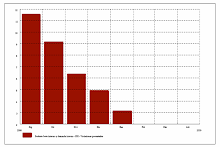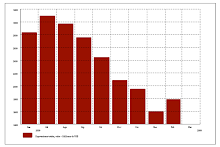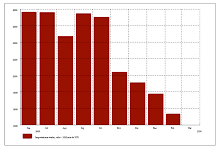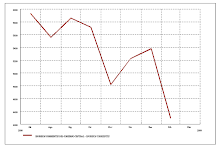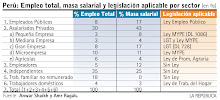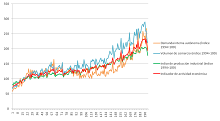The Latest Macro and Financial News Strongly Signal Recession Ahead
Nouriel Roubini | Dec 27, 2007
The latest macro and financial news confirm that the US is headed towards a hard landing – specifically a serious recession - as a vicious circle of worsening real fundamentals is perversely interacting with severely worsening financial fundamentals and a severe liquidity and credit crunch: Initial claims for unemployment benefits now at their recession level (i.e. level they had during the 2001 recession) and continued claims for unemployment benefits sharply up (signaling that workers losing jobs have a harder time finding new ones and are thus unemployed longer). This is now persistent trends for weeks signaling the beginning of a serious slack in the labor market.
Durable goods order falling – excluding transportation – for four months in a row; and non-defense capital goods orders and shipment falling too signaling that non-residential capex spending will show negative growth in Q4. No wonder as a slowing economy, economic/financial uncertainties and much higher corporate yield spreads (junk bond yields spreads now above 500bps compared to 200bps before the summer crisis) are taking a toll on capex spending by the corporate sector.
Consumer confidence still plunging (ABC/WaPo index) or sharply depressed even in December (Conference Board measure) in spite of a minor pick up in last survey. Consumer confidence close to recession levels. Polls showing that a majority of Americans expect a recession in the next 12 months.
Oil prices in the $90 to 100 range and now closer to the upper part of this range; significant negative real income effect of this increase in oil and energy prices. And overall headline and core inflation increasing.
Retail sales falling in real terms during the holiday seasons (as mediocre nominal growth was lower than inflation) and all the other indicators of holiday sales – including retailers' earnings and equity valuations showing serious gloom ahead. With consumption spending being over 70% of GDP a saving-less and debt burdened consumer that is buffeted by several shocks - falling home values, falling home equity withdrawal, rising debt servicing ratios with ARM resets, rising debt ratios, oil above $96, plunging consumer confidence, slack in the labor market - decided to throw in the towel in December and cut spending in real terms, for the first time since 2002.
The worst housing recession since the Great Depression getting worse and uglier with starts, permits, sales, prices, mortgage applications all sharply down and falling more; the only thing going up in housing is defaults, foreclosures and delinquencies.
Non-residential commercial real estate in serious trouble as a series of press reports and data suggest; CMBX index now at recession spreads.
Forward looking indicators of economic activity (Richmond Fed, Philly Fed manufacturing surveys, Index of Leading Indicators, ECRI leading indicators index) signaling weakness ahead and manufacturing ISM likely to fall below 50 (contraction level).
Corporate earnings falling 8.5% (y-o-y) in Q3 and expected to fall more in Q4 and ahead. And plunge in earnings are now spreading from home builders, to financial sector firms, to retail sector, to housing-related manufacturing and services, and overall business-cycle sensitive consumer discretionary firms. Stock market volatility still high and high nervousness and pessimism of investors (based on a variety of gauges of investors risk aversion – Vix, risk spread, etc.)
Interbank spreads (Libor vs. policy rates, TED spreads, BOR/OIS spreads, etc.) still at very elevated levels in spite of massive central bank injections and policy rate easing by Fed, BoE and BoC.
Bond yields curve and credit spreads pricing recession ahead.
Credit markets dead (subprime and subprime-related RMBs issuabce, subprime related CDOs issuance, and SIVs), comatose (near prime and prime and most of CDO and ABS issuance) or frozen (LBO deals cancelled, postponed, restructured, hundreds of leveraged loans on the balance sheet of banks, CLO issuance sharply down).
Unraveling of the $350 billion SIVs and collapse of the Super-Siv scheme forcing banks to bring back on balance sheet SIVs assets (re-intermediation), thus absorbing significant capital and liquidity and thus exacerbating the liquidity and credit crunch.
Signs of sharply increasing default rates on credit cards, auto loans and student loans leading the spreading of the credit crunch from mortgages to overall consumer credit. Banks and financial institutions have only recognized a small fraction of the total losses.
Corporate risk spreads sharply up – over 500bps – for junk bonds that were issued in massive amounts by the corporate sector in the last few years.
Monoliner bond insurance firms all under review for downgrade and one – ACA – already downgraded to C and on the verge of bankruptcy. Risk of hundreds of billions of losses for the underlying securities and issuers of insured bonds.
Massive further losses and writedowns by financial institutions that will increase as the crisis moves from subprime to near prime, prime, credit cards, auto loans, student loans, commercial real estate loans, leveraged loans, losses on ABS instruments, corporate loans. Unraveling of the Minsky credit cycle with losses reducing capital, reducing credit and exacerbating the credit crunch.
Pressures, losses and runs on non-bank financial institutions "the shadow banking system" (hedge funds, money market funds, state funds, investment banks, SIVs and conduits) that borrowed short and illiquid and lent long and illiquid that do not have direct or indirect access to the central banks' lender of last resort support.
Overall the most severe financial crisis in the Anglo-Saxon financial system in the last 20 years: crisis of insolvency and not just illiquidity; crisis of the "originate and distribute" model of securitization as wrong incentives and asymmetric information have led to a massive lack of confidence/trust in counterparties; rise of a disintermediated non-bank shadow financial system that is now in serious trouble. Need for massive reforms and regulations of the financial system.
US dollar falling and most of the financing of the still massive US current account deficit coming from central banks and SWFs, not private sector investors.
Geostrategic risks rising (being the assassination of Bhutto; unstable petro-states; high energy insecurity; political and policy uncertainty in the US as 2008 will be an election year).
Are there goods news out there? Of course there are some but many are old – relative to months before December - and backward looking:
Q3 growth being strong (but almost half of it was due to an inventory build-up and Q4 forecasts are now signaling growth below 1%);
non farm payrolls holding up in November (but initial claims for December are up and up);
personal real spending being strong in November after a weak September and October (but now December retail sales appear falling in real terms);
stock markets recovering being boosted by expectations of a Fed ease (but homebuilders, financials, retail and consumer discretionary being beaten up);
net exports improving modestly (but slowdown in global growth from re-coupling ahead will dampen the improvement in the trade balance);
hopes that a more aggressive Fed easing ahead will avoid a hard landing (but limited effects of such Fed cuts in a situation where you have a massive housing, consumer durables and auto glut; also Fed ability to ease aggressively limited by its inflation concerns and risks of a sharp inflationary fall of the dollar that may reduces foreigners investors' willingness to finance the US current account deficit);
financial institutions recapitalizing (but almost all of that recapitalization coming not from the private sectors but rather by government owned institutions – SWFs – in the Gulf, China and Singapore).
etc.: please add in the comments section any other major good news that I may have missed; I am not sure there is any.
It is thus pretty clear that the balance of the macro and financial news is strongly bearish. Thus, the most likely scenario is one of a serious US recession in 2008; the main issue now is not whether we will have a recession or not but rather how mild or severe such a recession will be.
17. TASAS DE INTERES Peru
16. tipo de cambio sol/dolar-consulta del dia
V. SECCION: M. PRIMAS
1. SECCION:materias primas en linea:precios
![[Most Recent Quotes from www.kitco.com]](http://www.weblinks247.com/indexes/gfms.gif) |
METALES A 30 DIAS click sobre la imagen
(click sur l´image)
2. PRECIOS MATERIAS PRIMAS
9. prix du petrole
10. PRIX essence
petrole on line
29 dic 2007
nouriel roubini : Recesion 2008
28 dic 2007
26 dic 2007
INFLACION ARGENTINA
Etiquetas: ECONOMIA
24 dic 2007
22 ago 2007
15 ago 2007
10 ago 2007
9 ago 2007
Fwd: Indicadores de USA al dia
I thought you might be interested in this information from The Financial Forecast (click) http://www.forecasts.org/index.htm
Regards,
gonzalo garcia
7 ago 2007
ESCRITOS AYER, VALEN HOY
DILEMAS DE LA INVERSION
LR, 28 FEBRERO 2005
EN QUE INVERTIR ? Quince de cada cien latinoamericanos carecen de agua potable. Veintitrés de saneamiento básico, disposición de excretas y conexiones domiciliarias.
Etiquetas: AFP, ECONOMIA, INFRAESTRUCTURA, INGENIERIA
6 ago 2007
EL VUELO DE LA COMETA
Bernardo Galvez, in memoriam
inscripción. (Mas....)
Etiquetas: CIP, INGENIERIA, INGENIEROS, LR, PLAN
EL VUELO DE LA COMETA
EL VUELO DE LA COMETA 26 JULIO 2005
Bernardo Galvez, in memoriam
Etiquetas: CIP, INGENIERIA, INGENIEROS, PLAN
1 ago 2007
27 jul 2007
ESCRITOS AYER,VALEN HOY
GAS DEL PERU
Escribe: Gonzalo García Núñez
LR, 11 de Julio 2005
El petróleo ha seguido en alza. El fin de semana supero la barrera de los sesenta dólares por barril WTI. El embalamiento se prolonga. Analistas de la bolsa de Nueva York prevén que el inicio del invierno del hemisferio norte será la hora de prueba de la tendencia futura de los precios. (Para leer todo, haga click sobre ESCRITOS ....)
26 jul 2007
ESCRITOS AYER,VALEN HOY
PAPA CON ROCOTO PICANTE
18 ABRIL 2005
Etiquetas: AGRO, ANDAHUAYLAS, ECONOMIA, LR, PAPA
PAPA CON ROCOTO, LR
Escribe: Gonzalo García Núñez
LR, 18 Abril 2005
El bajo precio de la papa blanca en Andahuaylas generó un movimiento de protesta de mayúsculas proporciones liderado por los productores del tubérculo. Ahora la demanda comunera brota en Ayacucho.
Los agricultores lograron una buena campaña. La cosecha abundante provocó una mayor oferta que los intermediarios remuneraron a la baja.
El precio de chacra tocó piso. Ínfimo. Muy por debajo de los costos. “A que tanto esfuerzo en hacer productiva la tierra si el rendimiento es nulo o peor, negativo”, cuenta un ingeniero de la región.
Esto motivó una movilización de los afectados que, por millares, solicitaron un mecanismo compensatorio a las autoridades.
Al no encontrar una respuesta vino la cólera. Los campesinos comuneros enarbolaron medidas de lucha cuyo desborde fue apenas encauzado por un dialogo a destiempo.
No faltaron los coscorrones verbales entre autoridades como el jabeo entre el congresista Michel Martínez y el Presidente del Consejo de Ministros.
Al final, se pactó un precio refugio y la fuerza pública restableció el orden (interrupciones de carretera, piqueteros..) con resultados lamentables.
Telón de fondo, el caso de la papa ilustra el rol de contención que ejercen los precios de la agricultura frente a otros efectos -como los combustibles- que inciden sobre el nivel general de precios.
Mientras que el alza del petróleo internacional golpea a nuestra economía, los precios del campo bajan y sirven de compuerta de cierre a las alzas importadas.
Para comprobarlo baste con mirar el crecimiento de precios desde el 2001. Allí se descubre que el gatillo de las alzas esta en combustibles.
De manera que los bajos precios que se pagan a nuestros agricultores juegan un rol estabilizador frente a la inflación importada al costo de la depresión de los ingresos de las chacras y de impresionantes niveles de pobreza rural.
No falta solucionatica. La plataforma de CONVEAGRO ha propuesto un programa equilibrado para elevar la productividad e ingreso agropecuario.
Tiene la enorme ventaja de aportar la participación y la experiencia directa de los agricultores a los escritorios del ministerio encargado.
Además transmite la preocupación de 33 gremios agrarios frente a la apertura indiscriminada del mercado a importaciones subsidiadas, según relató Juan Rheineck de CEPES en un encuentro reciente.
Preocupación que nace de una reciente experiencia del tratado con MERCOSUR en que los negociadores cholos no advirtieron los impactos desventajosos de esta apertura sobre nuestros productores lácteos.
Lo que agravó las pérdidas creadas por los desiguales términos de intercambio entre el campo y la ciudad.
Por eso la negociación con los EE.UU. en el TLC también despierta recelo.
Se piensa que los intereses locales podrían ser duramente afectados. Sobretodo en los productos más sensibles.
Sin considerar la pérdida fiscal que significa la decisión de un desarme arancelario inmediato. Y el costo de las compensaciones que, se anuncia, vendría por cuenta del tesoro publico que no por exiguas dejan de ser onerosas.
Por eso un tratado de comercio justo y conveniente, dotado de instrumentos compensatorios análogos a los usados con la papa blanca, serviría para ampliar el potencial de mercado sin afectar la economía de nuestros productores en una perspectiva de mayor plazo.
Esta regla se extiende a los otros ítems sujetos a negociación con el tío Sam. Para evitar la repetición de las circunstancias vividas en Andahuaylas, las evitables de Ayacucho o las que vienen con la anunciada movilización agraria.
Además estos TLCS debieran precaver medidas de reconversión estructural para limitar los daños que causa el comercio asimétrico. Financiamiento concesional de fuente externa y complementario al del gobierno para atenuar los efectos traumáticos de una cirugía sin anestesia, sinónimo de un TLC desprovisto de trato justo.
Igual preocupación surge cuando en la negociación del TLC no se advierte la existencia de instrumentos financieros para suavizar la naturaleza cíclica, subidas y bajadas, de la economía mundial.
En el TLC USA-Chile, por ejemplo, los mapochos se reservaron la capacidad de accionar frente a un movimiento de capitales brusco o inusitado. Cosa que sería útil de imitar, reserva de puro sentido común, para no quedar inermes frente a una crisis.
La idea cierta es que todos quieren un TLC que traiga mas beneficios que costos.
Etiquetas: AGRO, ALIMENTOS, GONZALO GARCIA, LAREPUBLICA, PAPA, PERU, TLC
21 jul 2007
ENTREVISTAS TV CRISIS GLOBAL
Etiquetas
- 1 MAYO
- 2
- 2002
- 2007
- 2008
- 2009
- 2010
- 2011
- 2012
- 2013
- 2014
- 2015
- 2016
- 2o11
- 2OO9
- a
- abr2015
- abril09
- abril10
- acc
- actualidadecono
- AFP
- AFPS
- AFRICA
- Ago11
- AGOS
- AGOST10
- agost12
- AGOSTO2008
- AGOSTO2009
- agosto2015
- AGRO
- AGROEXPORTACION
- AIG
- AL
- ALAGROEXPORTACION
- ALEMANIA
- ALIMENTOS
- amazonia
- AMERICALATINA
- ANDAHUAYLAS
- APEC
- ARCH MES
- ARGENTINA
- asarco
- ASIA
- ATTAC
- australia
- AUTOMOVIL
- AVAAZ
- b
- BAILOUT
- baltic
- BANCOS
- BC
- BCE
- BCRP
- benassy
- benedetti
- BERNANKE
- bernis
- BIELORUSIA
- BIS
- blanchard
- BOE
- BOJ
- BOLIVIA
- BOLSA
- BONUS
- BRASIL
- BRIC
- BUBBLE
- bundesbank
- C
- c rec
- CAFE
- CAMBIOCLIMATICO
- CAMERICAS
- CAN
- CANADA
- CANCION
- CAPITALISMO
- castro
- CDO
- cepij
- CHAVEZ
- cheque
- CHILE
- chimerica
- CHINA
- CHRYSLER
- CICLO
- CIE
- ciencia
- CIP
- COBRE
- COLOMBIA
- COMERCIO
- commodities
- COMPUTO
- CONSTRUCCION
- CONSUMO
- CONTAGIO
- control
- COPENHAGUE
- CORRUPCION
- coursera
- CRECIMIENTO
- CREDITO
- CRISIS
- CUBA
- CUMBREALCUE
- CUMBREALCUSA
- davos
- DEC08
- DEC11
- dec12
- DEC13
- dec15
- DEFICIT
- DEFLACION
- demanda
- DEPRESION
- DERIVADOS
- DEUDA
- developpement
- DIC09
- DIC10
- dic12
- DICIEMBRE
- do
- DOLAR
- doubledip
- dsk
- dubai
- duracion
- ec
- ecologo
- ECONOMIA
- ECUADOR
- EDUCA
- efectos
- EMPLEO
- EN11
- en16
- EN2016
- encuesta
- ene016
- energia
- ENERO
- ENERO09
- enero10
- EST
- eu
- EURO
- expansion
- EXPORTACION
- f
- fannie
- feb09
- feb10
- feb13
- feb15
- FED
- filo
- fin
- FINANZAS
- FINLANDIA
- fisica
- flu
- FMI
- FONDOS
- fr
- FRANCE
- frankfurt
- frontrunning
- fukushima
- G20
- G7
- GAS
- geab
- GEITHNER
- gini
- GLO
- global
- GM
- GONZALO GARCIA
- grece
- GREENSPAN
- GRENOBLE
- gripeporcina
- grupo mexico
- HAITI
- hambre
- HEDGE FUNDS
- HIPOTECA
- hist
- HOLLANDE
- HONDURAS
- IMPORTACION
- IMPUESTOS
- INDE
- INDIGNADOS
- INDUSTRIAL
- INFLACION
- INFORMALIDAD
- INFRAESTRUCTURA
- INGENIERIA
- INGENIEROS
- innova
- INTEGRACION
- INTERNACIONAL
- INVERSION
- IRAN
- IRLANDA
- ISLANDIA
- ismea
- ITALIA
- IZQ
- JAPON
- JUL11
- JULIO08
- JULIO09
- JULIO15
- JUN09
- jun10
- jun11
- JUN12
- jun13
- jun15
- JUNIO08
- keynes
- KRUGMAN
- lagarde
- LAREPUBLICA
- leap
- leverage
- liquidez
- LITIO
- lme
- LR
- macro
- MACROECONOMICS
- madera
- MADOFF
- MAMBIENTE
- MANGO
- MARS09
- mars10
- marx
- matematicas
- MATERIASPRIMAS
- MATUK
- MAY09
- MAY11
- MAY12
- MAY13
- may15
- may2015
- MAYO
- MBS
- me
- mef
- MERKEL
- METALES
- MEXICO
- miga
- MIGRA
- MINERIA
- MODELES
- MONDE
- MONEDA
- mourey
- MUJICA
- MUNDO
- musica clasica
- NACIONALIZACION
- neural
- niño
- nobel
- NOTASEMANAL
- NOV08
- nov09
- nov10
- NOV11
- NOV12
- nov15
- nuclear
- OBAMA
- OCDE
- oct09
- oct10
- OCT11
- oct12
- OCTUBRE08
- OFCE
- OIT
- OMC
- ORO
- paita
- PANAMA
- PAPA
- PARADIS
- PARAGUAY
- PAULSON
- pbi
- pe
- PEÑAFLOR
- PERU
- pesca
- PETROLEO
- piketty
- PLAN
- PMI
- POBLA
- POBREZA
- POL
- POLITICA
- porter
- portugal
- postcrisis
- PPT_CRISIS
- PRODUCCION
- PRODUCTIVIDAD
- profits
- prog
- PROTECCION
- QUIEBRA
- r
- RECESION
- REGULACION
- REMESAS
- REPEC
- REPRISE
- REPSOL
- RESERVAS
- RETAIL
- RGE
- RIESGOPAIS
- RMBS
- ROBOTICA
- RODRIK
- ROUBINI
- RUSIA
- SALARIOS
- SARKO
- school paris
- sep11
- SEP15
- SEQUIA
- SERVICIOS
- set09
- set10
- set11
- set12
- SET15
- SETIEMBRE08
- SINGAPUR
- SIRIA
- sismo
- soros
- southern
- SPAIN
- STANFORD
- STIGLITZ
- SUBPRIMES
- SUISSE
- SYRIZA
- TAIWAN
- TARIFAS
- TAS
- TCAMBIO
- TECNOLOGIA
- TERRITORIO
- TEXTIL
- TINTERES
- TLC
- TPP
- trabajo
- trentin
- TRICHET
- TROIKA
- tsunami
- TURISMO
- TV
- UBS
- UE
- UK
- UKRANIA
- UNASUR
- URUGUAY
- USA
- v
- VENEZUELA
- VIDEO
- vivienda
- WALL STREET
- WS
- wsj
- YEN
- young
- YUAN
- Zbasura
- zerohedge
Peru:crisis impacto regional arequipa,raul mauro
Temas CRISIS FINANCIERA GLOBAL
claves para pensar la crisis
-Tipo de cambio
- DIARIOS DE HOY
PRESS CLIPPINGS-RECORTES PRENSA-PRESSE..
canciones de GRACIAS A LA VIDA !
ETIQUETAS alfabetico
- 1 MAYO
- 2
- 2002
- 2007
- 2008
- 2009
- 2010
- 2011
- 2012
- 2013
- 2014
- 2015
- 2016
- 2o11
- 2OO9
- a
- abr2015
- abril09
- abril10
- acc
- actualidadecono
- AFP
- AFPS
- AFRICA
- Ago11
- AGOS
- AGOST10
- agost12
- AGOSTO2008
- AGOSTO2009
- agosto2015
- AGRO
- AGROEXPORTACION
- AIG
- AL
- ALAGROEXPORTACION
- ALEMANIA
- ALIMENTOS
- amazonia
- AMERICALATINA
- ANDAHUAYLAS
- APEC
- ARCH MES
- ARGENTINA
- asarco
- ASIA
- ATTAC
- australia
- AUTOMOVIL
- AVAAZ
- b
- BAILOUT
- baltic
- BANCOS
- BC
- BCE
- BCRP
- benassy
- benedetti
- BERNANKE
- bernis
- BIELORUSIA
- BIS
- blanchard
- BOE
- BOJ
- BOLIVIA
- BOLSA
- BONUS
- BRASIL
- BRIC
- BUBBLE
- bundesbank
- C
- c rec
- CAFE
- CAMBIOCLIMATICO
- CAMERICAS
- CAN
- CANADA
- CANCION
- CAPITALISMO
- castro
- CDO
- cepij
- CHAVEZ
- cheque
- CHILE
- chimerica
- CHINA
- CHRYSLER
- CICLO
- CIE
- ciencia
- CIP
- COBRE
- COLOMBIA
- COMERCIO
- commodities
- COMPUTO
- CONSTRUCCION
- CONSUMO
- CONTAGIO
- control
- COPENHAGUE
- CORRUPCION
- coursera
- CRECIMIENTO
- CREDITO
- CRISIS
- CUBA
- CUMBREALCUE
- CUMBREALCUSA
- davos
- DEC08
- DEC11
- dec12
- DEC13
- dec15
- DEFICIT
- DEFLACION
- demanda
- DEPRESION
- DERIVADOS
- DEUDA
- developpement
- DIC09
- DIC10
- dic12
- DICIEMBRE
- do
- DOLAR
- doubledip
- dsk
- dubai
- duracion
- ec
- ecologo
- ECONOMIA
- ECUADOR
- EDUCA
- efectos
- EMPLEO
- EN11
- en16
- EN2016
- encuesta
- ene016
- energia
- ENERO
- ENERO09
- enero10
- EST
- eu
- EURO
- expansion
- EXPORTACION
- f
- fannie
- feb09
- feb10
- feb13
- feb15
- FED
- filo
- fin
- FINANZAS
- FINLANDIA
- fisica
- flu
- FMI
- FONDOS
- fr
- FRANCE
- frankfurt
- frontrunning
- fukushima
- G20
- G7
- GAS
- geab
- GEITHNER
- gini
- GLO
- global
- GM
- GONZALO GARCIA
- grece
- GREENSPAN
- GRENOBLE
- gripeporcina
- grupo mexico
- HAITI
- hambre
- HEDGE FUNDS
- HIPOTECA
- hist
- HOLLANDE
- HONDURAS
- IMPORTACION
- IMPUESTOS
- INDE
- INDIGNADOS
- INDUSTRIAL
- INFLACION
- INFORMALIDAD
- INFRAESTRUCTURA
- INGENIERIA
- INGENIEROS
- innova
- INTEGRACION
- INTERNACIONAL
- INVERSION
- IRAN
- IRLANDA
- ISLANDIA
- ismea
- ITALIA
- IZQ
- JAPON
- JUL11
- JULIO08
- JULIO09
- JULIO15
- JUN09
- jun10
- jun11
- JUN12
- jun13
- jun15
- JUNIO08
- keynes
- KRUGMAN
- lagarde
- LAREPUBLICA
- leap
- leverage
- liquidez
- LITIO
- lme
- LR
- macro
- MACROECONOMICS
- madera
- MADOFF
- MAMBIENTE
- MANGO
- MARS09
- mars10
- marx
- matematicas
- MATERIASPRIMAS
- MATUK
- MAY09
- MAY11
- MAY12
- MAY13
- may15
- may2015
- MAYO
- MBS
- me
- mef
- MERKEL
- METALES
- MEXICO
- miga
- MIGRA
- MINERIA
- MODELES
- MONDE
- MONEDA
- mourey
- MUJICA
- MUNDO
- musica clasica
- NACIONALIZACION
- neural
- niño
- nobel
- NOTASEMANAL
- NOV08
- nov09
- nov10
- NOV11
- NOV12
- nov15
- nuclear
- OBAMA
- OCDE
- oct09
- oct10
- OCT11
- oct12
- OCTUBRE08
- OFCE
- OIT
- OMC
- ORO
- paita
- PANAMA
- PAPA
- PARADIS
- PARAGUAY
- PAULSON
- pbi
- pe
- PEÑAFLOR
- PERU
- pesca
- PETROLEO
- piketty
- PLAN
- PMI
- POBLA
- POBREZA
- POL
- POLITICA
- porter
- portugal
- postcrisis
- PPT_CRISIS
- PRODUCCION
- PRODUCTIVIDAD
- profits
- prog
- PROTECCION
- QUIEBRA
- r
- RECESION
- REGULACION
- REMESAS
- REPEC
- REPRISE
- REPSOL
- RESERVAS
- RETAIL
- RGE
- RIESGOPAIS
- RMBS
- ROBOTICA
- RODRIK
- ROUBINI
- RUSIA
- SALARIOS
- SARKO
- school paris
- sep11
- SEP15
- SEQUIA
- SERVICIOS
- set09
- set10
- set11
- set12
- SET15
- SETIEMBRE08
- SINGAPUR
- SIRIA
- sismo
- soros
- southern
- SPAIN
- STANFORD
- STIGLITZ
- SUBPRIMES
- SUISSE
- SYRIZA
- TAIWAN
- TARIFAS
- TAS
- TCAMBIO
- TECNOLOGIA
- TERRITORIO
- TEXTIL
- TINTERES
- TLC
- TPP
- trabajo
- trentin
- TRICHET
- TROIKA
- tsunami
- TURISMO
- TV
- UBS
- UE
- UK
- UKRANIA
- UNASUR
- URUGUAY
- USA
- v
- VENEZUELA
- VIDEO
- vivienda
- WALL STREET
- WS
- wsj
- YEN
- young
- YUAN
- Zbasura
- zerohedge
![[Most Recent Quotes from www.kitco.com]](http://www.kitconet.com/charts/metals/base/spot-copper-30d.gif)
![[Most Recent Quotes from www.kitco.com]](http://www.kitconet.com/charts/metals/base/zinc-d.gif)
![[Most Recent Quotes from www.kitco.com]](http://www.kitconet.com/charts/metals/base/lead-d.gif)
![[Most Recent Quotes from www.kitco.com]](http://www.kitconet.com/charts/metals/base/spot-nickel-30d.gif)





















